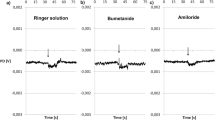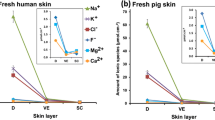Summary
The effect of addition of FeCl3 to the media bathing the isolated skin ofRana pipiens was studied by measuring short-circuit current, transepithelial potential, and resistance, and by determining the influx and efflux of sodium (J Na13 andJ Na31 , respectively) and the influx and efflux of chloride (J Cl13 andJ Cl31 , respectively) across the epithelium. With normal Ringer's solution on both sides of the skin, addition of 10−3 m FeCl3 to the external medium resulted in nearly complete inhibition of active Na transport (J Na13 decreased from 1.30±0.14 to 0.10±0.04 μeq/cm2 hr (N=8)) and in appearance of active chloride transport in outward direction due to an 80% increase inJ Cl31 . Average (J Cl31 −J Cl13 ) obtained from means of 8 skins in 6 consecutive control and last 3 experimental periods was −0.17±0.04 and 0.38±0.05 μeq/cm2 hr, respectively. FeCl3 added to external medium also induced substantial net chloride movement in outward direction when external medium contained Na-free choline chloride Ringer's or low ionic strength solution. Under the latter condition net Na movement was virtually eliminated by external FeCl3. After addition of FeCl3 to serosal medium there was delayed inhibition ofJ Na13 but no change in chloride fluxes. Immediate and profound changes in Na and Cl transport systems seen after external application of FeCl3 indicate charge effects of Fe3+ on surface of apical cell membranes, possibly close to or in ion channels.
Similar content being viewed by others
References
Benos, D.J., Simon, S.A., Mandel, L.J., Cala, P.M. 1976. Effect of amiloride and some of its analogues on cation transport in isolated frog skin and thin lipid membranes.J. Gen. Physiol. 68:43
Biber, T.U.L. 1971. Effect of changes in transepithelial transport on the uptake of sodium across the outer surface of the frog skin.J. Gen. Physiol. 58:131
Biber, T.U.L., Cruz, L.J. 1973. Effect of antidiuretic hormone on sodium uptake across outer surface of frog skin.Am. J. Physiol. 225:912
Biber, T.U.L., Curran, P.F. 1970. Direct measurement of uptake of sodium at the outer surface of the frog skin.J. Gen. Physiol. 56:83
Biber, T.U.L., Mullen, T.L. 1977. Effect of inhibitors on transepithelial efflux on Na and nonelectrolytes in frog skin.Am. J. Physiol. 237:C67
Biber, T.U.L., Mullen, T.L. 1980. The effect of external cation and anion substitutions on sodium transport in isolated frog skin.J. Membrane Biol. 52:121
Biber, T.U.L., Sanders, M.L. 1973. Influence of transepithelial potential difference on the sodium uptake of the outer surface of the isolated frog skin.J. Gen. Physiol. 61:529
Bunow, B., DeSimone, J.A. 1977. How is metabolic energy coupled to active transportIn: Proceedings of Symposium on Biophysics of Membrane Transport. p. 105. Wroclow University, Wroclow, Poland
Cereijido, M., Herrera, F.C., Flanigan, W.J., Curran, P.F. 1964. The influence of Na concentration or Na transport across frog skin.J. Gen. Physiol. 47:879
Cotton, F.A., Wilkinson, G.W. 1962. Advanced Inorganic chemistry. Interscience, New York
Cruz, L.T., Biber, T.U.L. 1976. Transepithelial transport kinetics and Na entry in frog skin: Effects of novobiocin.Am. J. Physiol. 231:1866
DeSimone, J.A. 1977. Perturbations in the structure of the double layer at an enzyme surface.J. Theor. Biol. 68:225
DeSousa, R.C. 1975. Mecanisms de transport de l'eau et du sodium per les cellules des epithelia d'amphibiens et du tubule renal isole.J. Physiol. (Paris) 71:5A
Diamond, T.M., Wright, E.M. 1969. Biological membranes: The physical basis of ion and nonelectrolyte selectivity.Annu. Rev. Physiol. 31:581
Hajjar, T.T., Abu-Murad, C., Khuri, R.N., Nassar, R. 1975. Effect of Mn2+ on permeability properties of frog skinPfluegers Arch. 359:57
Helman, S.I., Fisher, R.S. 1977. Microelectrode studies of the active Na transport pathway of frog skin.J. Gen. Physiol. 69:571
Herman, T.S. 1974. Effect of lanthanum (LA) on epithelial transport in toad bladder.Fed. Proc. 33(3):239
Hillyard, S.D., Gonick, H.C. 1976. Effects of Cd++ on short-circuit current across epithelial membranes.J. Membrane Biol. 26:109
Koefoed-Johnsen, V., Levi, H., Ussing, H.H. 1952. The mode of passage of chloride ions through the isolated frog skin.Acta Physiol. Scand. 25:150
Koefoed-Johnsen, V., Ussing, H.H. 1958. The nature of the frog skin potential.Acta Physiol. Scand. 42:298
Koefoed-Johnsen, V., Ussing, H.H., Zerahn, K. 1952. The origin of the short-circuit current in the adrenaline stimulated frog skin.Acta Physiol. Scand. 27:38
Mullen, T.L., Biber, T.U.L. 1978. Sodium uptake across outer surface of frog skin.In: Membrane Transport Processes. J.F. Hoffman, editor. pp. 199–212. Raven Press, New York
Nagel, W. 1975. Reinvestigation of intracellular PD of frog skin epithelium.In: Abstracts of the 5th International Biophysics Congress. p. 147. Copenhagen
Nagel, W. 1977. The dependence of the electrical potentials across the membranes of the frog skin upon the concentration of sodium in the mucosal solution.J. Physiol. (London) 269:777
Pauling, L. 1959. The nature of the chemical bond. Cornell University Press, Ithaca
Pennline, T.A., DeSimone, J.A., Rosenbaum, T.S., Mikulecky, D.C. 1977. A nonlinear boundary value problem arising in the structure of the double layer at an enzymatic surface.Math. Biosci. 37:1
Rick, R., Dorge, A., Arnim, E. von, Thurau, K. 1978. Electron microprobe analysis of frog skin epithelium: Evidence for a syncytial sodium transport compartment.J. Membrane Biol. 39:313
Singer, I., Civan, M.M. 1971. Effect of anions on sodium transport in toad urinary bladder.Am. J. Physiol. 221:1019
Tomlinson, R.W.S., Wood, A.W. 1978. Effect of amiloride on catecholamine-induced changes in ion transport in short-circuited frog skin.J. Membrane Biol. Special Issue: 135
Wietzerbin, T., Goudeau, H., Gary-Bobo, C.M. 1977. Influence of membrane polarization and hormonal stimulation on the action of Lanthanum on frog skin sodium permeability.Pfluegers Arch. 370:145
Zeiske, W., Lindemann, B. 1975. Blockage of Na-channels in frog skin by titration with protons and by chemical modification of COO-groups.Pfluegers Arch. 355:R71
Author information
Authors and Affiliations
Rights and permissions
About this article
Cite this article
Biber, T.U.L., Mullen, T.L. & DeSimone, J.A. Effect of FeCl3 on ion transport in isolated frog skin. J. Membrain Biol. 52, 133–139 (1980). https://doi.org/10.1007/BF01869118
Issue Date:
DOI: https://doi.org/10.1007/BF01869118




